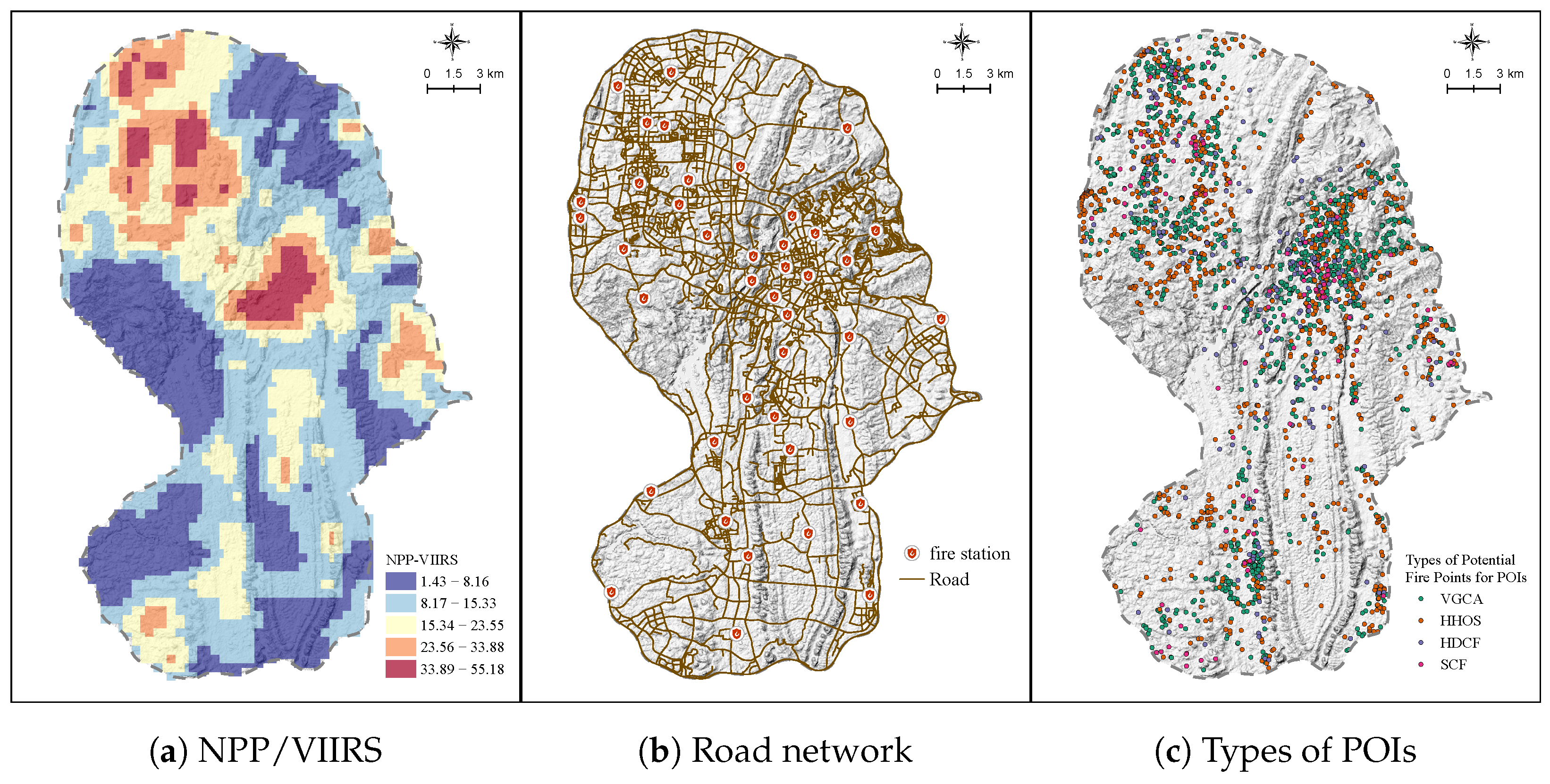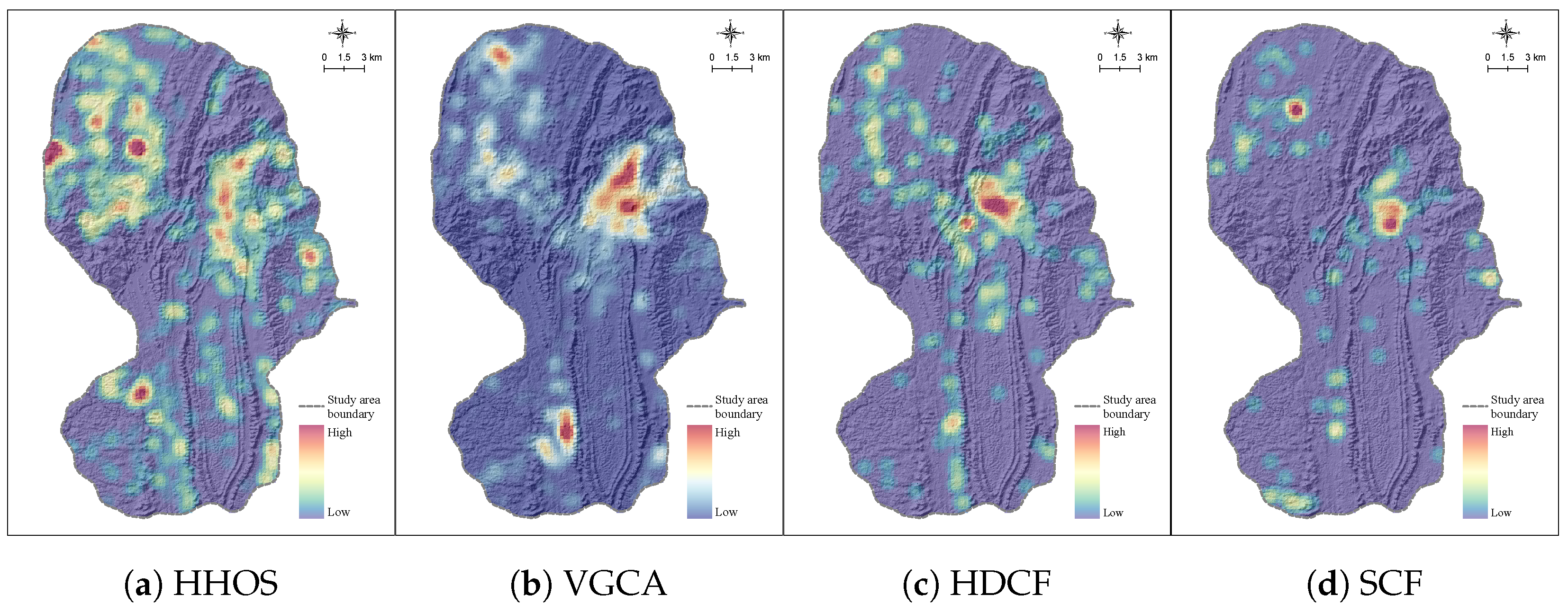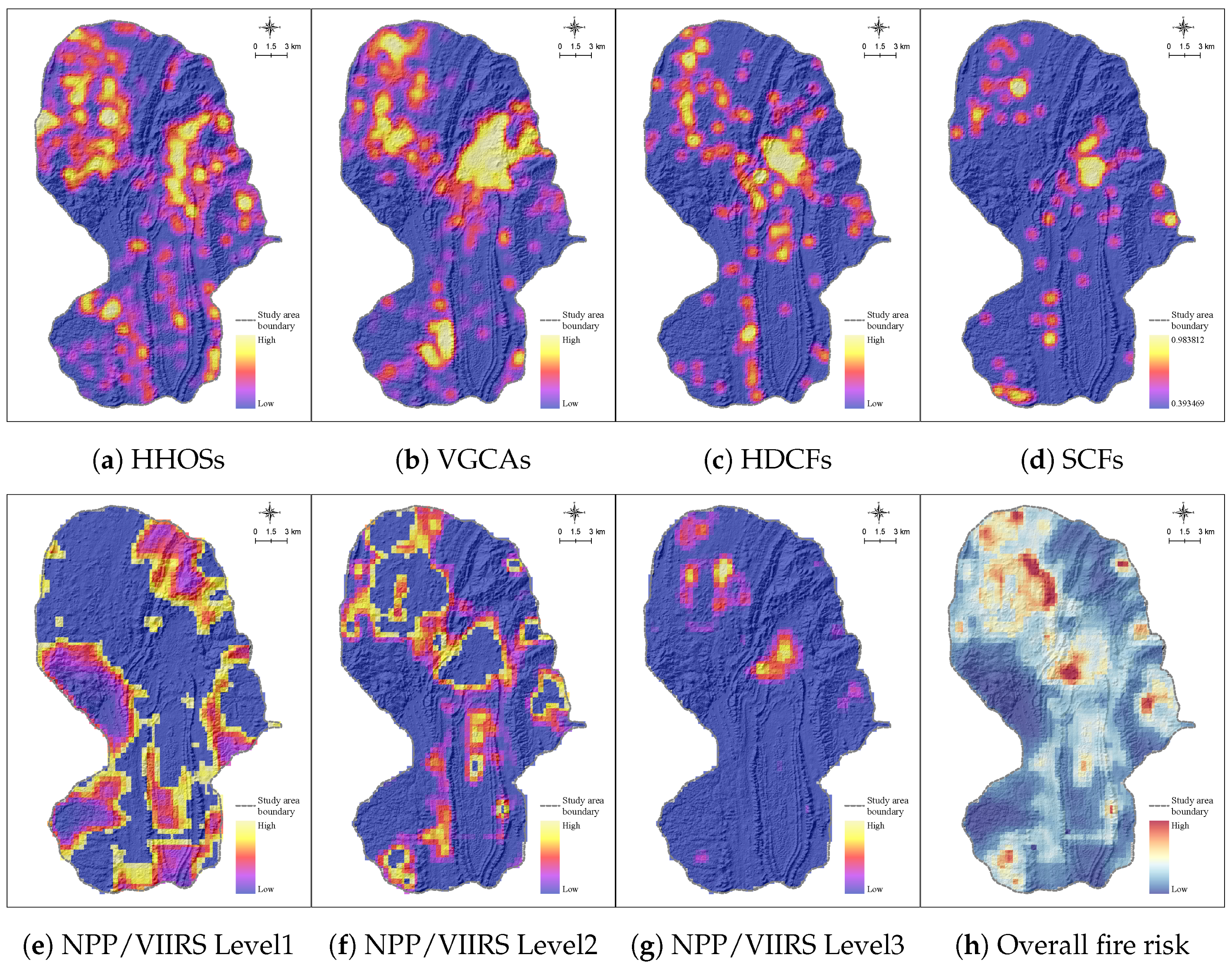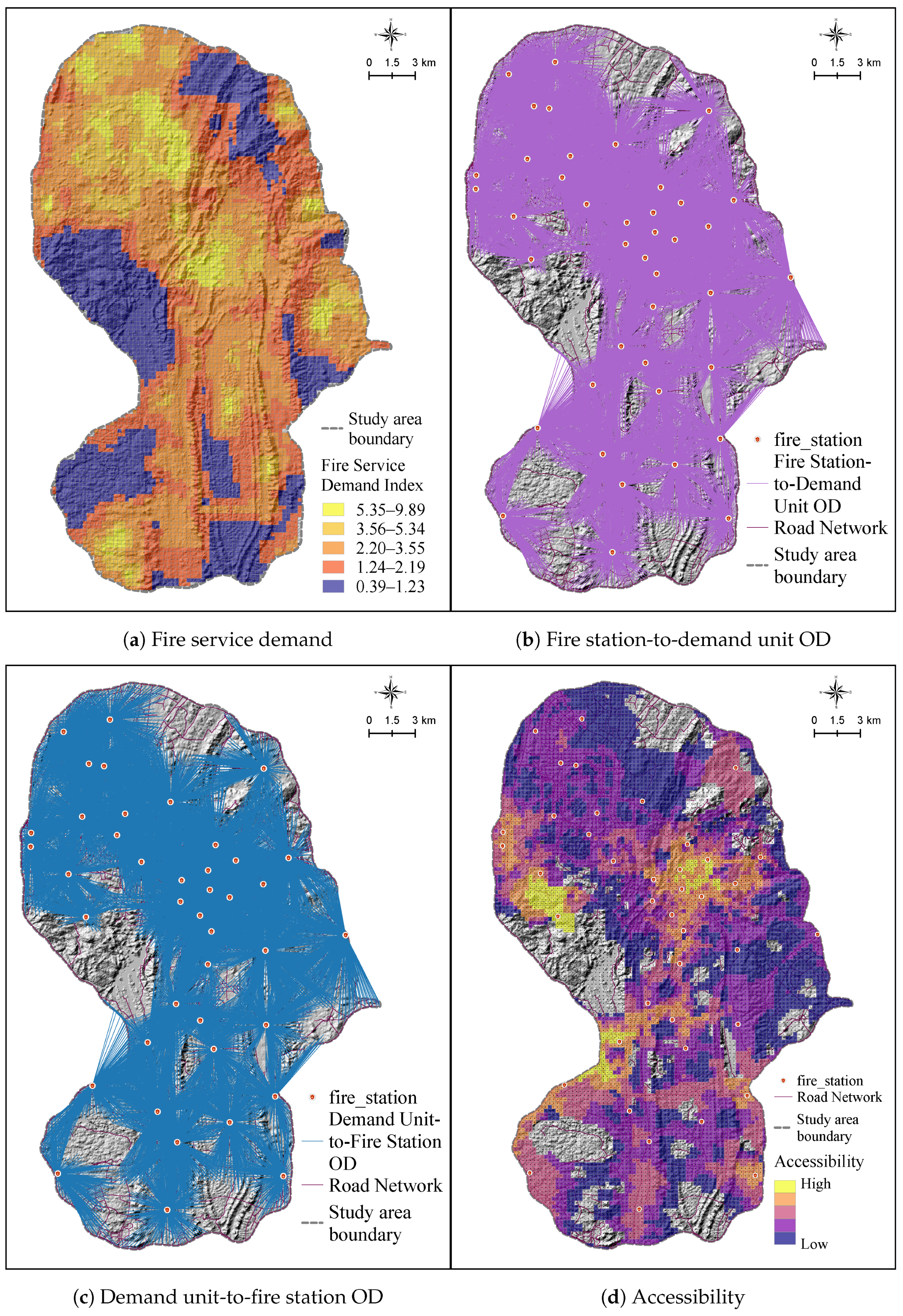Assessing Fire Station Accessibility in Guiyang, a Mountainous City, with Nighttime Light and POI Data: An Application of the Enhanced 2SFCA Approach
Abstract
1. Introduction
2. Literature Review
3. Study Area and Data Processing
3.1. Study Area
3.2. Data Sources and Pre-Processing
4. Methods
4.1. Research Design Flowchart
4.2. Urban Fire Risk Assessment
4.2.1. Facility-Type-Specific Kernel Density Analysis
4.2.2. Overall Fire Risk Assessment Based on SAVEE Model
- (1)
- Normalization
- (2)
- Superposition Operation
4.3. Fire Service Accessibility Assessment Using E2SFCA Method
4.3.1. Calculating the Supply–Demand Ratio for Each Fire Station
4.3.2. Measuring Accessibility for Each Demand Unit
5. Results
5.1. Kernel Density Analysis Results
5.2. SAVEE Model Analysis Results
5.3. E2SFCA Analysis Results
5.4. Spatial Clustering of Fire Station Accessibility
5.4.1. Global Spatial Autocorrelation Analysis
5.4.2. Local Spatial Autocorrelation Analysis
6. Discussion
7. Conclusions
Author Contributions
Funding
Data Availability Statement
Conflicts of Interest
References
- Alexandridis, A.; Russo, A.; Vakalis, D.; Siettos, C.I.; Bafas, G.V. Wildland fire spread modelling using cellular automata: Evolution in large-scale spatially heterogeneous environments under fire suppression tactics. Int. J. Wildland Fire 2011, 20, 633–647. [Google Scholar] [CrossRef]
- Jiang, Y.; Lv, A.; Yan, Z.; Yang, Z. A GIS-Based Multi-Criterion Decision-Making Method to Select City Fire Brigade: A Case Study of Wuhan, China. ISPRS Int. J. Geo-Inf. 2021, 10, 777. [Google Scholar] [CrossRef]
- Syphard, A.D.; Radeloff, V.C.; Keeley, J.E.; Hawbaker, T.J.; Clayton, M.K.; Stewart, S.I.; Hammer, R.B. Human influence on California fire regimes. Ecol. Appl. 2007, 17, 1388–1402. [Google Scholar] [CrossRef]
- Moritz, M.A.; Batllori, E.; Bradstock, R.A.; Gill, A.M.; Handmer, J.; Hessburg, P.F.; Leonard, J.; McCaffrey, S.; Odion, D.C.; Schoennagel, T.; et al. Learning to coexist with wildfire. Nature 2014, 515, 58–66. [Google Scholar] [CrossRef]
- Keeley, J.E.; Syphard, A.D. Climate change and future fire regimes: Examples from California. Geosciences 2016, 6, 37. [Google Scholar] [CrossRef]
- Moraga-Orinda Fire District. Ordinance No. 23-08: An Ordinance of the Moraga-Orinda Fire District of Contra Costa County, California, Adopting Requirements for Fuel Breaks on Certain Parcels in Both the State Responsibility and Local Responsibility Areas Within the Fire District, Adopting Findings of Fact Regarding Fire Hazards in the Fire District, Adopting Findings of Exemption Under the California Environmental Quality Act, and Repealing Ordinance 23-04, 2023. Available online: https://www.cityoforinda.org/DocumentCenter/View/4455/5-MOFD-Ordinance-23-03-Defensible-Space-and-Exterior-Hazard-Abatement-Ordinance?bidId= (accessed on 17 September 2025).
- Callenberger, B.; Dowling, J.; Lunder, Z. Olympic Valley Community Wildfire Protection Plan. Technical Report, Deer Creek Resources and Olympic Valley Public Service District, Olympic Valley, California, 2022. Developed with Input from Placer County, CAL FIRE, U.S. Forest Service, and Others. Available online: https://ovpsd.org/wp-content/uploads/2024/06/2022-11-15_OV_CWPP_FINAL.pdf (accessed on 17 September 2025).
- Han, S.Y.; Lee, Y.; Yoo, J.; Kang, J.Y.; Park, J.; Myint, S.W.; Cho, E.; Gu, X.; Kim, J.S. Spatial Disparities in Fire Shelter Accessibility: Capacity Challenges in the Palisades and Eaton Fires. arXiv 2025, arXiv:2506.06803. [Google Scholar] [CrossRef]
- KC, K.; Ardianto, R.; Wang, S. Examining fire service coverage and potential sites for fire station locations in Kathmandu, Nepal. Urban Inform. 2024, 3, 20. [Google Scholar] [CrossRef]
- Bustillo Sánchez, M.; Tonini, M.; Mapelli, A.; Fiorucci, P. Spatial assessment of wildfires susceptibility in Santa Cruz (Bolivia) using random forest. Geosciences 2021, 11, 224. [Google Scholar] [CrossRef]
- Lemmertz, C.K.; de Oliveira Rodrigues, A.; Mu, L.V.; Centeno, F.R. Fire vulnerability of informal settlements: A case study for Porto Alegre City (Brazil). Fire Technol. 2025, 61, 1383–1407. [Google Scholar] [CrossRef]
- Wang, K.; Yuan, Y.; Chen, M.; Wang, D. A POIs based method for determining spatial distribution of urban fire risk. Process Saf. Environ. Prot. 2021, 154, 447–457. [Google Scholar] [CrossRef]
- Wang, A.; Zhang, Q.; Lu, L.; Yu, H.; Huang, C. Urban Fire Risk Assessment and Planning Response Based on Multi-Source Data. China Saf. Sci. J. 2021, 31, 148–155. [Google Scholar] [CrossRef]
- Li, R.; Wang, J.; Li, M. Fine-Resolution Evaluation of Urban Fire Service Accessibility Under the Impact of a 100-Year Pluvial Flood. Prog. Geogr. 2022, 41, 143–156. [Google Scholar] [CrossRef]
- Chen, M.; Wang, Y.; Zheng, Z.; You, X.; Zeng, Y. Modeling the Forest Fire Risk by Incorporating a New Human Activity Factor from Nighttime Light Data. Geocarto Int. 2023, 38, 1–20. [Google Scholar] [CrossRef]
- Hansen, W.G. How Accessibility Shapes Land Use. J. Am. Inst. Planners 1959, 25, 73–76. [Google Scholar] [CrossRef]
- Morris, J.M.; Dumble, P.L.; Wigan, M.R. Accessibility Indicators for Transport Planning. Transp. Res. Part A Gen. 1979, 13, 91–109. [Google Scholar] [CrossRef]
- Nicholls, S. Measuring the Accessibility and Equity of Public Parks: A Case Study Using GIS. Manag. Leis. 2001, 6, 201–219. [Google Scholar] [CrossRef]
- Ergen, M. Using the Buffer Zone Method to Measure the Accessibility of the Green Areas in Tokat, Turkey. In Landscape Architecture—Processes and Practices Towards Sustainable Development; IntechOpen: London, UK, 2020. [Google Scholar] [CrossRef]
- Chen, X.; Pei, T.; Song, C.; Shu, H.; Guo, S.; Wang, X.; Liu, Y.; Chen, J.; Zhou, C. Accessing Public Transportation Service Coverage by Walking Accessibility to Public Transportation under Flow Buffering. Cities 2022, 125, 103646. [Google Scholar] [CrossRef]
- Guagliardo, M.F. Spatial Accessibility of Primary Care: Concepts, Methods and Challenges. Int. J. Health Geogr. 2004, 3, 3. [Google Scholar] [CrossRef]
- Liu, Y.; Gu, H.; Shi, Y. Spatial Accessibility Analysis of Medical Facilities Based on Public Transportation Networks. Int. J. Environ. Res. Public Health 2022, 19, 16224. [Google Scholar] [CrossRef]
- Balasubramani, K.; Gomathi, M.; Prasad, S. GIS-based Service Area Analysis for Optimal Planning Strategies: A Case Study of Fire Service Stations in Madurai City. Geogr. Anal. Union Geogr.-Infor-Mation Technol. 2016, 5, 11–18. [Google Scholar]
- Elsheikh, R. GIS-based Services Analysis and Multi-Criteria for Optimal Planning of Location of a Police Station. Gazi Univ. J. Sci. 2022, 35, 1248–1258. [Google Scholar] [CrossRef]
- Yang, D.H.; Goerge, R.; Mullner, R. Comparing GIS-based methods of measuring spatial accessibility to health services. J. Med Syst. 2006, 30, 23–32. [Google Scholar] [CrossRef]
- Radke, J.; Mu, L. Spatial Decompositions, Modeling and Mapping Service Regions to Predict Access to Social Programs. Ann. GIS 2000, 6, 105–112. [Google Scholar] [CrossRef]
- Luo, W.; Wang, F. Measures of spatial accessibility to health care in a GIS environment: Synthesis and a case study in the Chicago region. Environ. Plan. B Plan. Des. 2003, 30, 865–884. [Google Scholar] [CrossRef] [PubMed]
- Luo, W.; Wang, F. Spatial accessibility to primary care and physician shortage area designation: A case study in Illinois with GIS approaches. In Geographic Information Systems and Health Applications; IGI Global: Hershey, PA, USA, 2003; pp. 261–279. [Google Scholar]
- Chen, X.; Jia, P. A comparative analysis of accessibility measures by the two-step floating catchment area (2SFCA) method. Int. J. Geogr. Inf. Sci. 2019, 33, 1739–1758. [Google Scholar] [CrossRef]
- Tao, Z.; Dai, T.; Song, C. Improving spatial equity-oriented location-allocation models of urban medical facilities. Acta Geogr. Sin. 2023, 78, 474–489. [Google Scholar]
- Wang, F. Measurement, optimization, and impact of health care accessibility: A methodological review. Ann. Assoc. Am. Geogr. 2012, 102, 1104–1112. [Google Scholar] [CrossRef]
- Dai, D. Black residential segregation, disparities in spatial access to health care facilities, and late-stage breast cancer diagnosis in metropolitan Detroit. Health Place 2010, 16, 1038–1052. [Google Scholar] [CrossRef]
- Luo, W.; Qi, Y. An enhanced two-step floating catchment area (E2SFCA) method for measuring spatial accessibility to primary care physicians. Health Place 2009, 15, 1100–1107. [Google Scholar] [CrossRef]
- Szymon, W. Fire Service Accessibility to Potential Intervention Areas in Łódź Voivodship. Saf. & Fire Technol. 2016, 43, 21–36. [Google Scholar] [CrossRef]
- Wiśniewski, S. The Use of Network Analyst Tool and 2SFCA Method to Assess Fire Service Effectiveness in a City, as Exemplified by Łódź. Geomat. Landmanagement Landsc. 2017, 147–158. [Google Scholar] [CrossRef]
- Xia, Z.; Li, H.; Chen, Y.; Yu, W. Integrating Spatial and Non-Spatial Dimensions to Measure Urban Fire Service Access. ISPRS Int. J. Geo-Inf. 2019, 8, 138. [Google Scholar] [CrossRef]
- Kiran, K.C.; Corcoran, J.; Chhetri, P. Measuring the Spatial Accessibility to Fire Stations Using Enhanced Floating Catchment Method. Socio-Econ. Plan. Sci. 2020, 69, 100673. [Google Scholar] [CrossRef]
- Sahebgharani, A.; Haghshenas, H. Analyzing Accessibility to Fire Stations: A Floating Catchment Area Model for Stochastic Transportation Networks with Travel Time Correlation. Trans. GIS 2022, 26, 182–200. [Google Scholar] [CrossRef]
- Zeng, W.; Zhong, Y.; Li, D.; Deng, J. Classification of recreation opportunity spectrum using night lights for evidence of humans and POI data for social setting. Sustainability 2021, 13, 7782. [Google Scholar] [CrossRef]
- Li, L.; Li, N.; Wu, X.; Liu, B. A method for evaluating the spatial layout of fire stations in chemical industrial parks. Appl. Sci. 2024, 14, 2918. [Google Scholar] [CrossRef]
- Chen, Y.; Yao, J.; Wang, S.; Lai, Z.; Wu, L.; Dong, G. Location optimization of urban fire stations considering the variations in fire service demands: A bi-objective coverage model. Int. J. Digit. Earth 2025, 18, 2454386. [Google Scholar] [CrossRef]
- Mellander, C.; Lobo, J.; Stolarick, K.; Matheson, Z. Night-Time Light Data: A Good Proxy Measure for Economic Activity? PLoS ONE 2015, 10, e0139779. [Google Scholar] [CrossRef]
- Meng, Y.; Zhou, S.; Nie, Y.; Zeng, H.; Yu, J. Spatial Delimitation of the Urban-Rural Fringe Based on POI and Nighttime Light Data: A Case Study of Wuhan City. Geomat. Inf. Sci. Wuhan Univ. 2025, 50, 449–461. [Google Scholar] [CrossRef]
- Gao, C.; Li, J.; Wu, T.; Wang, R.; Wang, J.; Chen, H.; Jiang, Y. Spatialisation of GDP based on NPP-VIIRS night lighting and urban utilization. In Proceedings of the 3rd International Academic Conference on Blockchain, Information Technology and Smart Finance (ICBIS 2024), Kuala Lumpur, Malaysia, 23–25 February 2024; Atlantis Press: Dordrecht, The Netherlands, 2024; pp. 173–179. [Google Scholar] [CrossRef]
- Amaral, S.; Monteiro, A.M.V.; Camara, G.; Quintanilha, J.A. DMSP/OLS Night-time Light Imagery for Urban Population Estimates in the Brazilian Amazon. Int. J. Remote Sens. 2006, 27, 855–870. [Google Scholar] [CrossRef]
- Bagan, H.; Yamagata, Y. Analysis of Urban Growth and Estimating Population Density Using Satellite Images of Nighttime Lights and Land-Use and Population Data. GIScience Remote Sens. 2015, 52, 765–780. [Google Scholar] [CrossRef]
- Lu, D.; Wang, Y.; Yang, Q.; Su, K.; Zhang, H.; Li, Y. Modeling Spatiotemporal Population Changes by Integrating DMSP-OLS and NPP-VIIRS Nighttime Light Data in Chongqing, China. Remote Sens. 2021, 13, 284. [Google Scholar] [CrossRef]
- Keola, S.; Andersson, M.; Hall, O. Monitoring Economic Development from Space: Using Nighttime Light and Land Cover Data to Measure Economic Growth. World Dev. 2015, 66, 322–334. [Google Scholar] [CrossRef]
- Agnihotri, J.; Mishra, S. Indian Economy and Nighttime Lights. In Proceedings of the 2021 International Conference on Computational Intelligence and Knowledge Economy (ICCIKE), Dubai, United Arab Emirates, 17–18 March 2021; pp. 401–406. [Google Scholar] [CrossRef]
- Xia, Z.; Li, H.; Chen, Y. An integrated spatial clustering analysis method for identifying urban fire risk locations in a network-constrained environment: A case study in nanjing, china. ISPRS Int. J. Geo-Inf. 2017, 6, 370. [Google Scholar] [CrossRef]
- Chen, M.; Wang, K.; Yuan, Y.; Yang, C. A Pois Based Method for Location Optimization of Urban Fire Station: A Case Study in Zhengzhou City. Fire 2023, 6, 58. [Google Scholar] [CrossRef]
- Tao, L.; Cui, Y.; Xu, Y.; Chen, Z.; Guo, H.; Huang, B.; Xie, Z. Location Optimization of Urban Fire Stations Considering the Backup Coverage. Int. J. Environ. Res. Public Health 2022, 20, 627. [Google Scholar] [CrossRef]
- Klein, R.H. Quality of Life Assessment as a Preliminary Study on the Spatial Appraisal and Valuation of Environment and Ecosystems Methodology. Master’s Thesis, Texas A&M University, College Station, TX, USA, 2011. [Google Scholar]
- Loh, K.D.; Tapaneeyakul, S. GIS for Environmental Problem Solving. In Sustainable Development—Authoritative and Leading Edge Content for Environmental Management; Curkovic, S., Ed.; IntechOpen: London, UK, 2012; Chapter 4. [Google Scholar] [CrossRef]
- Loh, D.K.; Hsieh, Y.T.C.; Choo, Y.K.; Holtfrerich, D.R. Integration of a rule-based expert system with GIS through a relational database management system for forest resource management. Comput. Electron. Agric. 1994, 11, 215–228. [Google Scholar] [CrossRef]
- Loh, D.K.; Hsieh, Y.T.C. Incorporating rule-based modeling of succession in a savanna landscape. AI Appl. 1995, 9, 29–40. [Google Scholar]
- Loh, D.K.; Van Stipdonk, S.E.; Holtfrerich, D.R.; Hsieh, Y.T.C. Spatially constrained reasoning for the determination of wildlife foraging areas. Comput. Electron. Agric. 1996, 15, 323–334. [Google Scholar] [CrossRef]
- Dan, K.; Wang, R.; Tian, L.; Wang, X. Evaluation of Groundwater Exploitation on Islands Based on the SAVEE Method. J. Ocean Technol. 2020, 39, 78–83. [Google Scholar]
- Chen, S.; Xiao, L.; Liu, N.; Gong, Y.; Xiao, Y. Classificatory Assessment of Islands and Reefs in the South China Sea from the Perspective of Sustainable Development. Trop. Geogr. 2022, 42, 1039–1049. [Google Scholar]
- Wang, W.; Xu, Z.; Sun, D.; Lan, T. Spatial Optimization of Mega-City Fire Stations Based on Multi-Source Geospatial Data: A Case Study in Beijing. ISPRS Int. J. Geo-Inf. 2021, 10, 282. [Google Scholar] [CrossRef]
- Tan, L.; Qu, N.; Han, L.; Sui, Y. Fire Risk Assessment of Industrial Cities Based on the GIS-SAVEE Model. J. Inst. Disaster Prev. 2023, 25, 97–103. [Google Scholar]
- Liao, S.; Cai, H.; Tian, P.; Zhang, B.; Li, Y. Combined Impacts of the Abnormal and Urban Heat Island Effect in Guiyang, a Typical Karst Mountain City in China. Urban Clim. 2022, 41, 101014. [Google Scholar] [CrossRef]
- Guiyang City Statistics Bureau; National Bureau of Statistics Guiyang Investigation Team. 2024 Guiyang City Statistical Bulletin on National Economic and Social Development. 2025. Available online: https://www.guiyang.gov.cn/zwgk/zfxxgks/fdzdgknr/tjxx/tjgb/202504/t20250401_87326147.html (accessed on 17 June 2025).
- Xu, X. China Annual Nighttime Light Dataset. 2022. Available online: https://www.resdc.cn/DOI/doi.aspx?DOIid=105 (accessed on 9 February 2025).
- Xu, X. Multi-year County-Level Administrative Boundary Data of China. Registration and Publishing System. 2023. Available online: https://www.resdc.cn/DOI/doi.aspx?DOIid=120 (accessed on 9 February 2025).
- Wang, Q.; Su, F.; Zhang, Y.; Jiang, H.; Cheng, F. Morphological Precision Assessment of Reconstructed Surface Models for a Coral Atoll Lagoon. Sustainability 2018, 10, 2749. [Google Scholar] [CrossRef]
- Huo, F.; Hu, C.; Lei, P.; Jiang, S.; Qu, F. Risk Level-oriented Optimization of Multi-level Coverage Fire Station Location. J. Catastrophology 2025, 40, 178–184. [Google Scholar] [CrossRef]
- Ministry of Public Security of the People’s Republic of China. Code for Fire Station Construction in Urban Areas (Construction Standard 152—2017); China Planning Press: Beijing, China, 2017. [Google Scholar]
- Zhou, T.; Liu, D.; Liu, W.; Li, Y.; Zhu, S.; Wang, J.; Shi, L. Hierarchical Dynamic Estimation of Fire Service Accessibility Based on POI Big Data. Case Stud. Therm. Eng. 2024, 59, 104503. [Google Scholar] [CrossRef]
- Hong-yan, G.; Cheng-tai, D. Discussion on the impact of karst topography to urban development—A case in Guiyang City. Carsologica Sin. 2010, 29, 81–86. [Google Scholar]









| Data Type | Description | Source/Platform |
|---|---|---|
| Nighttime light data | NPP/VIIRS data (2021) | Resource and Environmental Science Data platform [64] |
| POI data of fire stations and possible fire points | Crawled using Python (version 3.9.13) from Gaode Map API (2023) | Gaode Map |
| Road network data | Road network of Guiyang City (2023) | OpenStreetMap |
| Administrative division map | Guiyang City administrative boundaries (2022) | Resource and Environmental Science Data platform [65] |
| Digital Elevation Model (DEM) data | 12.5 m resolution DEM for Guiyang City | Resource and Environmental Science Data platform |
| Statistical yearbook data | Socioeconomic statistics | Guiyang City Statistical Yearbook (2023) |
| Type | Moran’s I | z-Score | p-Value |
|---|---|---|---|
| Fire service demand magnitude | 0.953673 | 126.621167 | 0.000000 |
| Accessibility | 0.852655 | 168.266966 | 0.000000 |
| Type | General G | z-Score | p-Value |
|---|---|---|---|
| Fire service demand magnitude | 0.000150 | 124.364550 | 0.000000 |
| Accessibility | 0.000200 | 164.351598 | 0.000000 |
Disclaimer/Publisher’s Note: The statements, opinions and data contained in all publications are solely those of the individual author(s) and contributor(s) and not of MDPI and/or the editor(s). MDPI and/or the editor(s) disclaim responsibility for any injury to people or property resulting from any ideas, methods, instructions or products referred to in the content. |
© 2025 by the authors. Published by MDPI on behalf of the International Society for Photogrammetry and Remote Sensing. Licensee MDPI, Basel, Switzerland. This article is an open access article distributed under the terms and conditions of the Creative Commons Attribution (CC BY) license (https://creativecommons.org/licenses/by/4.0/).
Share and Cite
He, X.; Wu, B.; Shen, G.; Lyu, Q.; Ofori, G. Assessing Fire Station Accessibility in Guiyang, a Mountainous City, with Nighttime Light and POI Data: An Application of the Enhanced 2SFCA Approach. ISPRS Int. J. Geo-Inf. 2025, 14, 393. https://doi.org/10.3390/ijgi14100393
He X, Wu B, Shen G, Lyu Q, Ofori G. Assessing Fire Station Accessibility in Guiyang, a Mountainous City, with Nighttime Light and POI Data: An Application of the Enhanced 2SFCA Approach. ISPRS International Journal of Geo-Information. 2025; 14(10):393. https://doi.org/10.3390/ijgi14100393
Chicago/Turabian StyleHe, Xindong, Boqing Wu, Guoqiang Shen, Qianqian Lyu, and Grace Ofori. 2025. "Assessing Fire Station Accessibility in Guiyang, a Mountainous City, with Nighttime Light and POI Data: An Application of the Enhanced 2SFCA Approach" ISPRS International Journal of Geo-Information 14, no. 10: 393. https://doi.org/10.3390/ijgi14100393
APA StyleHe, X., Wu, B., Shen, G., Lyu, Q., & Ofori, G. (2025). Assessing Fire Station Accessibility in Guiyang, a Mountainous City, with Nighttime Light and POI Data: An Application of the Enhanced 2SFCA Approach. ISPRS International Journal of Geo-Information, 14(10), 393. https://doi.org/10.3390/ijgi14100393






